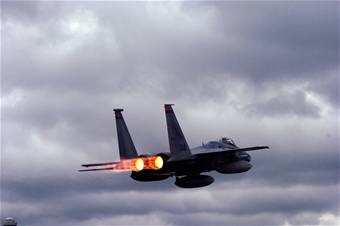F-15 Engine Tested On Tri-Fuel Blend
An F-15 Eagle engine is undergoing performance testing at Arnold
Air Force Base in Tennessee using a unique blend of three different
fuel types. The F100 engine is being tested with a combination of
JP-8 conventional aviation fuel; a biofuel derived from tallow,
which is an animal fat; and a synthetic fuel derived from coal
through a process commonly known as Fisher-Tropsch.

File Photo Courtesy U.S. Air Force
The fuels testing is being conducted to ensure the different
fuels, in varying combinations, are suitable for an upcoming series
of F-15 flight tests tentatively scheduled for October at Eglin Air
Force Base, FL, said Brian Knack, the Aerospace Testing Alliance's
program engineer for the test. ATA is the operating contractor at
the Arnold Engineering Development Center. "This (first phase of
the test) evaluated a 50 percent (by volume) tallow-derived fuel,
while the final phase is bringing Fischer-Tropsch-derived fuel
together with the bio-fuel forming yet another new and unique
blend," he said.
Testing has simulated the overall engine conditions experienced
at near sea-level conditions. A baseline test using JP-8 was
performed in the first phase of the test program. Then, a blend of
50 percent tallow-derived fuel and 50 percent JP-8 was evaluated.
Finally, a blend of 25 percent tallow-derived fuel and 25 percent
synthetic fuel and 50 percent JP-8 was evaluated.
"They've engineered these alternative fuel blends, both the
tallow and FT, to meet the existing JP-8 (specifications)
requirements," Knack said. "So, we're just verifying that, although
it's within the same specification chemically, that it doesn't
adversely affect engine performance."
Second Lt. Drew Miller, the AEDC's project manager for the test,
pointed out that this entry is not a certification test series per
se, nor is it intended to include an analysis of "wear and
tear" on the engine. "We'rejust demonstrating that the engine can
successfully perform on the biofuels that we're testing," he
said.

File Photo Courtesy U.S. Air Force
Engineers from the Air Force Alternative Fuels Certification
Office at Wright-Patterson AFB, OH, noted that the hydro-treated
renewable jet biofuels -- currently only available in research and
development quantities -- are expensive. The expectation is that
once they are certified for use by the Air Force and by airlines
participating in the Commercial Aviation Alternative Fuels
Initiative, industry producers will respond to the market demand
and prices will fall in line with conventional jet fuel.
Lieutenant Miller said it's important to view this test from a
wider perspective. "The Secretary of the Air Force has an
initiative to reduce our dependence on oil (by) 50 percent by 2016,
and this is just leading the way to make that happen," he said.
"The Air Force is the largest oil consumer in the Department of
Defense, and this is a major step towards increasing our
independence."
Knack said he is already looking toward the future of bio-fuels.
"This is the next step of biofuel evolution, and a couple years
from now we could be running algae-based fuels or whatever is
deemed to be the most efficient, economically produced on a mass
production level," he said. "Then we will probably see it
here."
 ANN's Daily Aero-Linx (04.13.24)
ANN's Daily Aero-Linx (04.13.24) ANN's Daily Aero-Term (04.13.24): Beyond Visual Line Of Sight (BVLOS)
ANN's Daily Aero-Term (04.13.24): Beyond Visual Line Of Sight (BVLOS) Airborne 04.09.24: SnF24!, Piper-DeltaHawk!, Fisher Update, Junkers
Airborne 04.09.24: SnF24!, Piper-DeltaHawk!, Fisher Update, Junkers Aero-News: Quote of the Day (04.14.24)
Aero-News: Quote of the Day (04.14.24) ANN's Daily Aero-Term (04.14.24): Maximum Authorized Altitude
ANN's Daily Aero-Term (04.14.24): Maximum Authorized Altitude




